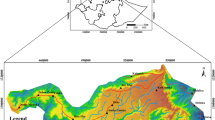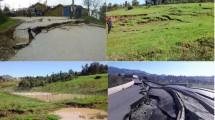Abstract
Landslide susceptibility zonation is a widely studied method for assessing the likelihood of landslides in specific areas. This study focuses on the Ranikhola watershed in the Sikkim Himalaya and utilizes the Frequency Ratio (FR) and Modified Information Value (MIV) methods to analyse landslide susceptibility. To enhance the susceptibility mapping a novel approach for the FR and MIV is introduced where the factor classes of higher importance were utilized. The study further evaluates a methodology that incorporates weighted ranking of landslide conditioning factor classes using FR and MIV indexes to generate landslide susceptibility maps (LSM). The landslide inventory comprises 124 landslides identified through satellite imagery from Q-GIS quick maps, ESRI base map, Google Earth, and Sentinel 2 A & B. Sixteen conditioning factors are considered, including elevation, slope angle, aspect, curvature, drainage characteristics, vegetation index, geology, soil type, rainfall, road density, and land use. The LSI and LSM are derived from these factors. The LSM created using traditional FR and MIV methods show that 9.55% and 5.96% of the watershed area fall within the High Susceptibility Zone (HSZ) and Very High Susceptibility Zone (VHSZ), respectively. However, the novel approach reveals that 11.54% and 10.29% of the study area fall within the HSZ and VHSZ. The weighted ranking method indicates that 16.22% of the Ranikhola watershed area is within the HSZ and VHSZ. The models are evaluated using the area under the receiver operating characteristic curve (AUC), with FR and MIV methods producing AUC values of 0.77 and 0.68, respectively. The new approach improves the AUC of the MIV method to 0.76, while the FR method remains relatively unchanged. The weighting method outperforms other FR and MIV methods, with an AUC of 0.90. Correlation analysis of the condition factors suggests that profile curvature, slope, stream power index, and topographic wetness index are the most influential factors, positively impacting each other and contributing to higher landslide susceptibility. The study emphasizes the importance of incorporating weighted ranking of landslide conditioning factor classes to create LSM, rather than relying on the total landslide susceptibility index (LSI) of factors. The findings provide valuable data for future large-scale investigations and efforts to enhance hazard preparedness in the Ranikhola watershed.











Similar content being viewed by others
Data availability
The datasets used and/or analysed during the current study are available from the corresponding author on reasonable request.
References
Anbalagan R, Kumar R, Lakshmanan K, Parida S, Neethu S (2015) Landslide hazard zonation mapping using frequency ratio and fuzzy logic approach, a case study of Lachung Valley. Sikkim Geoenviron Disasters 2(1):6. https://doi.org/10.1186/s40677-014-0009-y
Avinash KG, Ashamanjari KG (2010) A GIS and frequency ratio based landslide susceptibility mapping: Aghnashini river catchment, Uttara Kannada, India. Int J Geomatics Geosci 1(3):343–354
Bera A, Mukhopadhyay BP, Das D (2019) Landslide hazard zonation mapping using multi-criteria analysis with the help of GIS techniques: A case study from Eastern Himalayas, Namchi. South Sikkim Natural Hazards 96(2):935–959. https://doi.org/10.1007/s11069-019-03580-w
Beven KJ, Kirkby MJ (1979) A physically based, variable contributing area model of basin hydrology/Un modèle à base physique de zone d’appel variable de l’hydrologie du bassin versant. Hydrolog Sci J 24(1):43–69
Bhasin R, Aslan G, Dehls J (2023) Ground investigations and detection and monitoring of landslides using SAR Interferometry in Gangtok, Sikkim Himalaya. Geohazards 4(1):25–39
Choi J, Oh H-J, Lee H-J, Lee C, Lee S (2012) Combining landslide susceptibility maps obtained from frequency ratio, logistic regression, and artificial neural network models using ASTER images and GIS. Eng Geol 124:12–23. https://doi.org/10.1016/j.enggeo.2011.09.011
Chowdhuri I, Pal SC, Arabameri A, Ngo PTT, Chakrabortty R, Malik S, Das B, Roy P (2020) Ensemble approach to develop landslide susceptibility map in landslide dominated Sikkim Himalayan region, India. Environ Earth Sci 79(20):476. https://doi.org/10.1007/s12665-020-09227-5
Chowdhuri I, Pal SC, Chakrabortty R, Malik S, Das B, Roy P, Sen K (2021) Spatial prediction of landslide susceptibility using projected storm rainfall and land use in Himalayan region. Bull Eng Geol Env 80(7):5237–5258. https://doi.org/10.1007/s10064-021-02252-z
Dutta K, Wanjari N, Misra AK (2023) Stability analysis of road cut slopes in Sikkim Himalaya along national highway 10, India. Geol Ecol Landsc 1–14
Egan JP (1975) Signal detection theory and ROC analysis. Academic Press, New York Ercanoglu M, Gokceoglu C (2002) Assessment of landslide susceptibility for a landslide prone area (north of Yenice, NW Turkey) by fuzzy approach. Environ Geol 41:720–730
Fawcett T (2006) An introduction to ROC analysis. Pattern Recogn Lett 27(8):861–874
Fell R, Corominas J, Bonnard C, Cascini L, Leroi E, Savage WZ (2008) Guidelines for landslide susceptibility, hazard and risk zoning for land use planning. Eng Geol 102(3):85–98. https://doi.org/10.1016/j.enggeo.2008.03.022
Gorsevski PV, Gessler PE, Foltz RB, Elliot WJ (2006) Spatial prediction of landslide hazard using logistic regression and ROC analysis. Trans GIS 10(3):395–415
GSI, Bhukosh dataset (2022) Geological Survey of India. Government of India, Kolkata. https://bhukosh.gsi.gov.in/Bhukosh/Public
Gupta N, Pal SK, Das J (2022a) GIS-based evolution and comparisons of landslide susceptibility mapping of the East Sikkim Himalaya. Ann GIS 28(3):359–384. https://doi.org/10.1080/19475683.2022.2040587
Gupta V, Kumar S, Hermanns R, Penna I, Dehls J, Sengupta A, Bhasin RK (2022b) Spatial prediction of landslide susceptibility zones using Artificial Neural Network in the Sikkim Himalaya, India. In EGU General Assembly Conference Abstracts (pp EGU22–11496)
Huang F, Cao Z, Guo J, Jiang S-H, Li S, Guo Z (2020) Comparisons of heuristic, general statistical and machine learning models for landslide susceptibility prediction and mapping. CATENA 191:104580. https://doi.org/10.1016/j.catena.2020.104580
Hutchinson JN (1995) Keynote paper: landslide hazard assessment. In: Bell (ed) Landslides. Balkema, Rotterdam, pp 1805–1841
Intarawichian N, Dasananda S (2011) Frequency ratio model based landslide susceptibility mapping in lower Mae Chaem watershed, Northern Thailand. Environ Earth Sci 64:2271–2285
Kanungo D, Mehrotra GS, Sarkar S, Mahadeviah K (1996) Terrain analysis and spatial assessment of landslide hazard in parts of Sikkim Himalaya. J Geol Soc India 47:491–498
Karim S, Jalileddin S, Ali MT (2011) Zoning landslide by use of frequency ratio method (case study: Deylaman Region). Middle-East J Sci Res 9(5):578–583
Kaur H, Gupta S, Parkash S, Thapa R, Gupta A, Khanal GC (2019) Evaluation of landslide susceptibility in a hill city of Sikkim Himalaya with the perspective of hybrid modelling techniques. Ann GIS 25(2):113–132. https://doi.org/10.1080/19475683.2019.1575906
Lee S, Pradhan B (2007) Landslide hazard mapping at Selangor, Malaysia using frequencyratio and logistic regression models. Landslides 4(1):33–41
Lee S, Talib JA (2005) Probabilistic landslide susceptibility and factor effect analysis. Environ Geol 47:982–990
Mandal S, Mandal K (2018a) Bivariate statistical index for landslide susceptibility mapping in the Rorachu river basin of eastern Sikkim Himalaya India. Spatial Inf Res 26(1):59–75. https://doi.org/10.1007/s41324-017-0156-9
Mandal S, Mandal K (2018b) Modeling and mapping landslide susceptibility zones using GIS based multivariate binary logistic regression (LR) model in the Rorachu river basin of eastern Sikkim Himalaya, India. Model Earth Syst Environ 4(1):69–88. https://doi.org/10.1007/s40808-018-0426-0
Mandal S, Mondal S (2019) Statistical approaches for landslide susceptibility assessment and prediction, vol 27. Springer
Mandal K, Saha S, Mandal S (2021) Applying deep learning and benchmark machine learning algorithms for landslide susceptibility modelling in Rorachu river basin of Sikkim Himalaya. India Geoscience Frontiers 12(5):101203. https://doi.org/10.1016/j.gsf.2021.101203
Nandi A, Shakoor A (2009) A GIS-based landslide susceptibility evaluation using bivariate and multivariate statistical analyses. Eng Geol 110:11–20
Pradhan B, Lee S (2010) Landslide susceptibility assessment and factor effect analysis: Back propagation artificial neural networks and their comparison with frequency ratio and bivariate logistic regression modelling. Environ Model Softw 25:747–759
Ramakrishnan D, Ghose MK, Chandran RV, Jeyaram A (2005) Probabilistic Techniques, GIS and Remote Sensing in Landslide Hazard Mitigation: A Case Study from Sikkim Himalayas, India. Geocarto Int 20(4):53–58. https://doi.org/10.1080/10106040508542364
Saha A, Mandal S, Saha S (2020) Geo-spatial approach-based landslide susceptibility mapping using analytical hierarchical process, frequency ratio, logistic regression and their ensemble methods. SN Appl Sci 2(10):1647. https://doi.org/10.1007/s42452-020-03441-3
Saha S, Roy J, Pradhan B, Hembram TK (2021) Hybrid ensemble machine learning approaches for landslide susceptibility mapping using different sampling ratios at East Sikkim Himalayan, India. Adv Space Res 68(7):2819–2840. https://doi.org/10.1016/j.asr.2021.05.018
Sarkar S, Kanungo D, Patra A, Kumar P (2006) GIS based landslide susceptibility mapping—a case study in indian himalaya, disaster mitigation of debris flows, slope failures and landslides, pp. 617–624, Universal Academy Press, Inc. / Tokyo, Japan. https://www.researchgate.net/profile/D-Kanungo/publication/242073557_GIS_Based_Landslide_Susceptibility_Mapping_-_A_Case_Study_in_Indian_Himalaya/links/0c960528c38a2b19b4000000/GIS-Based-Landslide-Susceptibility-Mapping-A-Case-Study-in-Indian-Himalaya.pdf
Sarkar S, Kanungo DP, Patra AK, Kumar P (2008) GIS based spatial data analysis for landslide susceptibility mapping. J Mt Sci 5(1):52–62. https://doi.org/10.1007/s11629-008-0052-9
Sharma LP, Patel N, Ghose MK, Debnath P (2014) Application of frequency ratio and likelihood ratio model for geo-spatial modelling of landslide hazard vulnerability assessment and zonation: A case study from the Sikkim Himalayas in India. Geocarto Int 29(2):128–146. https://doi.org/10.1080/10106049.2012.748830
Sonker I, Tripathi JN, Singh AK (2021) Landslide susceptibility zonation using geospatial technique and analytical hierarchy process in Sikkim Himalaya. Quat Sci Adv 4:100039. https://doi.org/10.1016/j.qsa.2021.100039
Swets JA (1988) Measuring the accuracy of diagnostic systems. Science 240(4857):1285–1293. https://doi.org/10.1126/science.3287615
Tehrani FS, Calvello M, Liu Z, Zhang L, Lacasse S (2022) Machine learning and landslide studies: recent advances and applications. Nat Hazards 114(2):1197–1245
Valdiya KS (2015) The making of India: geodynamic evolution. Springer
Varnes DJ (1984) Landslide Hazard Zonation: A review of principles and practice, Commission on Landslides of the IAEG. UNESCO Natural Hazards 3:61
Wang Q, Wang D, Huang Y, Wang Z, Zhang L, Guo Q, Chen W, Chen W, Sang M (2015) Landslide Susceptibility Mapping Based on Selected Optimal Combination of Landslide Predisposing Factors in a Large Catchment. Sustainability 7(12):16653–16669. https://doi.org/10.3390/su71215839
Williams CJ, Lee SS, Fisher RA, Dickerman LH (1999) A comparison of statistical methods for prenatal screening for Down syndrome. Appl Stochastic Models Data Anal 15:89–101
Zhang T, Li Y, Wang T, Wang H, Chen T, Sun Z, Han L (2022) Evaluation of different machine learning models and novel deep learning-based algorithm for landslide susceptibility mapping. Geoscience Letters 9(1):1–16
Acknowledgements
The authors would like to express their gratitude for the research facilities provided by the Department of Geology, Sikkim University, which were instrumental in conducting the study described in this manuscript.
Author information
Authors and Affiliations
Contributions
Kuldeep Dutta played a pivotal role in collecting field data, processing & interpretation of GIS & RS data and developing the framework for the study, while Nishchal Wanjari and Anil Kumar Misra provided valuable assistance in data interpretation and manuscript writing. The authors confirm that all co-authors have thoroughly reviewed and approved the final version of the manuscript.
Corresponding author
Ethics declarations
Ethics approval and consent to participate
Not applicable.
Consent for publication
Not applicable.
Competing interests
Authors do not have any financial and non-financial competing interests reported in the manuscript.
Additional information
Responsible Editor: Zeynal Abiddin Erguler
Rights and permissions
Springer Nature or its licensor (e.g. a society or other partner) holds exclusive rights to this article under a publishing agreement with the author(s) or other rightsholder(s); author self-archiving of the accepted manuscript version of this article is solely governed by the terms of such publishing agreement and applicable law.
About this article
Cite this article
Dutta, K., Wanjari, N. & Misra, A.K. Landslide susceptibility assessment in Sikkim Himalaya with RS & GIS, augmented by improved statistical methods. Arab J Geosci 17, 138 (2024). https://doi.org/10.1007/s12517-024-11944-1
Received:
Accepted:
Published:
DOI: https://doi.org/10.1007/s12517-024-11944-1




